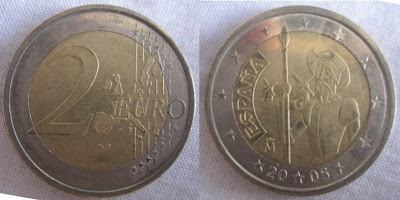Spain 1 Euro, 1999

Spain 2 Euro, 1999
 The 1 and 2 euro coins of spain show Juan Carlos I (born in Rome, 5 January 1938) is the reigning King of Spain.
The 1 and 2 euro coins of spain show Juan Carlos I (born in Rome, 5 January 1938) is the reigning King of Spain.On 22 November 1975, two days after the death of dictator Francisco Franco, Juan Carlos was designated King according to the law of succession promulgated by Franco. The Spanish throne had been vacant for twenty-two years (1947 restoration) in 1969 when Franco named Juan Carlos as the next ruler of Spain.
On 22 November 1975, two days after the death of dictator Francisco Franco, Juan Carlos was designated King according to the law of succession promulgated by Franco. The Spanish throne had been vacant for twenty-two years (1947 restoration) in 1969 when Franco named Juan Carlos as the next ruler of Spain. The Spanish Constitution affirms the role of the Spanish monarch as the personification and embodiment of the Spanish nation, a symbol of Spain's enduring unity and permanence; and as such, the monarch is the head-of-state and commander-in-chief of the Spanish Armed Forces in a system known in Spanish as "monarquía parlamentaria" (parliamentary monarchy).
King Juan Carlos successfully oversaw the transition of Spain from dictatorship to parliamentary democracy.
Juan Carlos married Sophia of Greece and Denmark in 1962. The couple has three children and eight grandchildren.
Polls from 2000 show that he is widely approved of by Spaniards. According to the Spanish Constitution, the monarch is also instrumental in promoting Ibero-American relations, the "nations of its historical community".
Spain 2 Euro, 400th anniversary of Don Quixote
 This 2 Euro coin was released in 2005 on the occasion of the 400th anniversary of the publication of Cervantes’ Don Quixote de la Mancha. Throughout Spain and in cities such as Dallas, Mexico City, Paris, Brussels, Oran, Algeria, and St. Petersburg, Cervantes’ novel was celebrated with plays, debates, exhibitions, concerts and films. “Don Quixote Round the World”, a travelling exhibition featuring paintings, drawings and engravings, begins a world-wide tour of book fairs in April.
This 2 Euro coin was released in 2005 on the occasion of the 400th anniversary of the publication of Cervantes’ Don Quixote de la Mancha. Throughout Spain and in cities such as Dallas, Mexico City, Paris, Brussels, Oran, Algeria, and St. Petersburg, Cervantes’ novel was celebrated with plays, debates, exhibitions, concerts and films. “Don Quixote Round the World”, a travelling exhibition featuring paintings, drawings and engravings, begins a world-wide tour of book fairs in April.The first edition of Book One of Don Quixote came off a printing press in Madrid on December 20, 1604, and reached the public on Jan 6, 1605. The novel quickly became an international best seller. Four centuries on, it still ranks as the most published and translated book after the Bible.
The novel tells the story of Don Quixote, a humble, book-loving village gent who dries up his brain by reading too many cheap romances, and decides to throw it all in to become a knight errant.
He puts on a cardboard helmet, mounts an old horse and sets off across the plain with his faithful sidekick, Sancho Panza. They are searching for a peasant girl from a nearby village who the Don imagines is a noble princess. Along the way they sow chaos and confusion wherever they go.
Don Quixote has been variously described as the first great European novel, the first work of modern literature and the foundation of Latin American fiction.
"All prose fiction is a variation on the theme of Don Quixote," the American critic Lionel Trilling wrote in 1950.
In 2002, the novel was voted the best book of all time by a group of 100 writers, including Salman Rushdie, Nadine Gordimer, Wole Soyinka and Norman Mailer, in a survey organized by editors at the Norwegian Book Club in Oslo.



No comments:
Post a Comment